I’m regularly dazzled by the athletic abilities of birds. It happened again yesterday and this time it involved prey.
I wish some of the photos were better but I was shooting through a tunnel of vegetation so I was lucky to get any sharp shots at all. But they still clearly document the incredibly quick reflexes and athleticism of this small songbird.
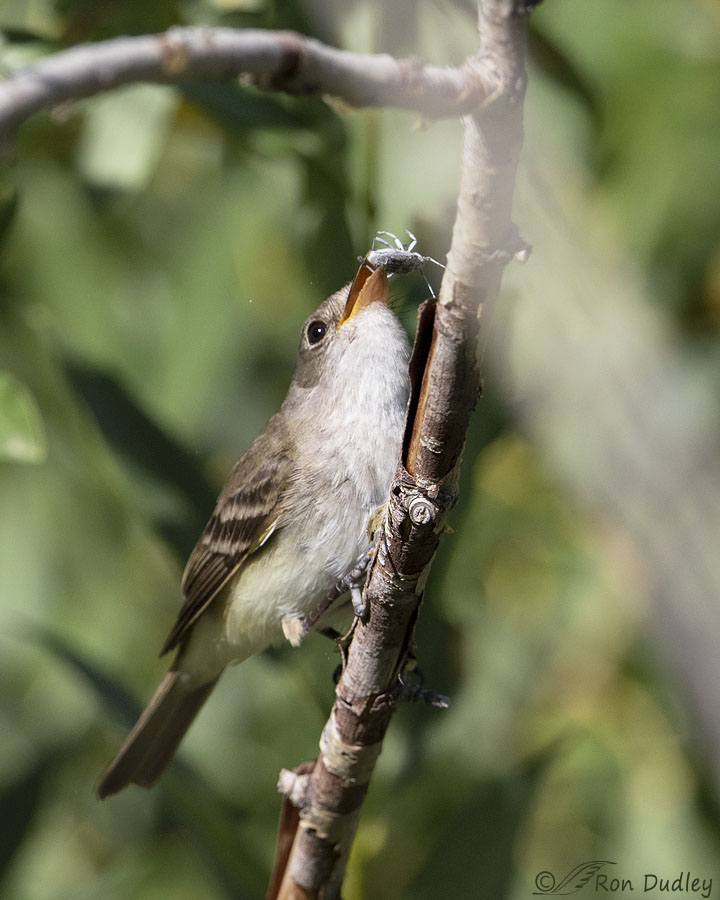
The flycatcher had been hawking insects from the air but this time his victim was a large and apparently flightless insect he’d captured on vegetation or on the ground. He was manipulating it in his bill when…
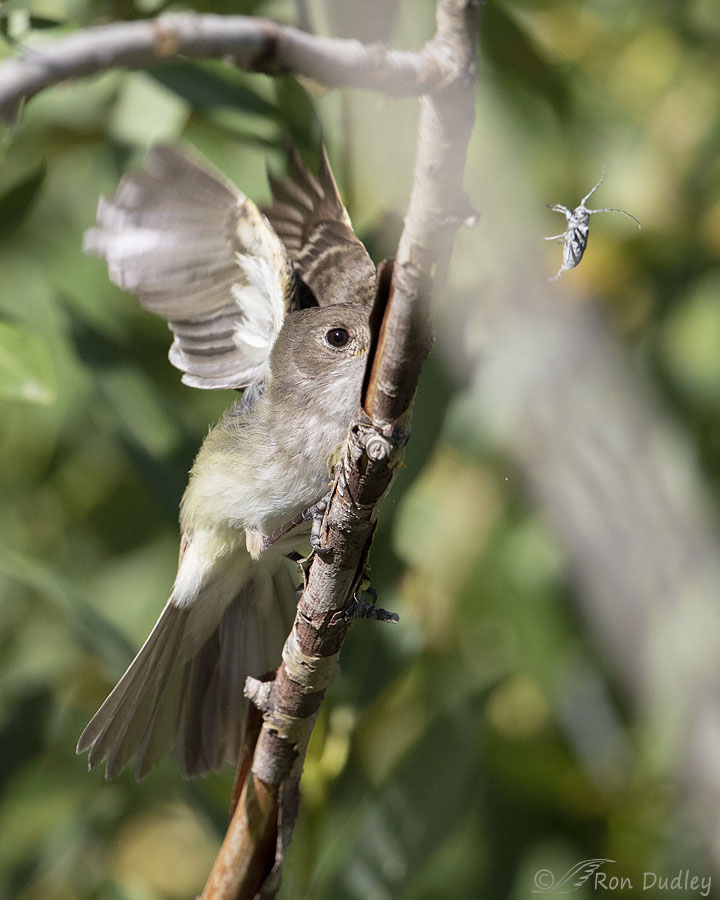
the insect suddenly went flying through the air. In an instant the flycatcher had already reacted by raising his wings.
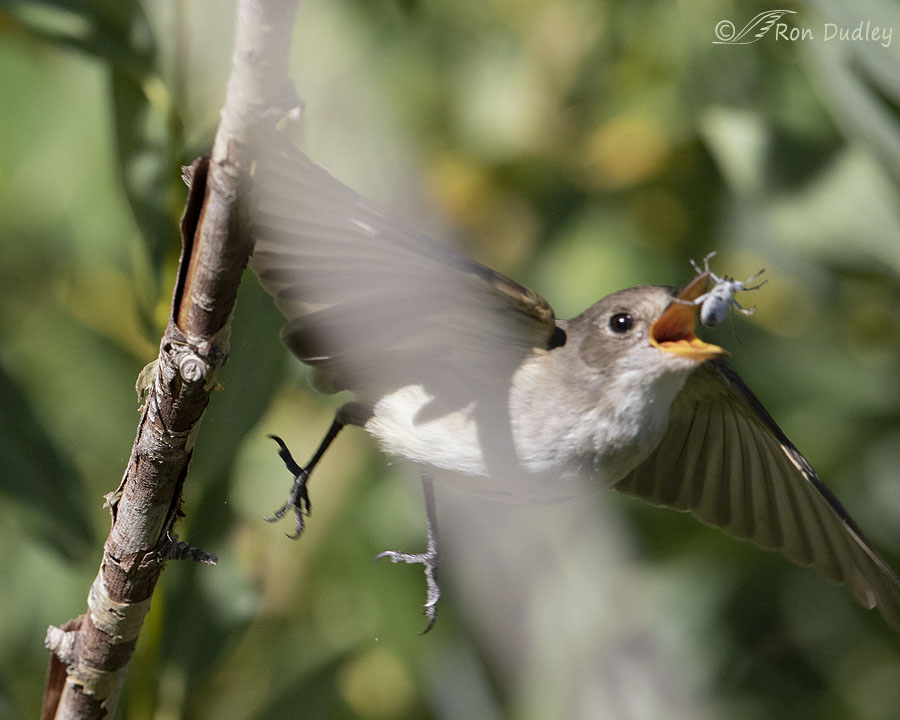
Amazingly he managed to catch the bug again before it had fallen more than about an inch vertically.
The flycatcher and insect are soft because the out of focus diagonal branch between my lens and the flycatcher prevented my active focus point from following the bird but it’s still clear that the insect was recaptured very quickly.
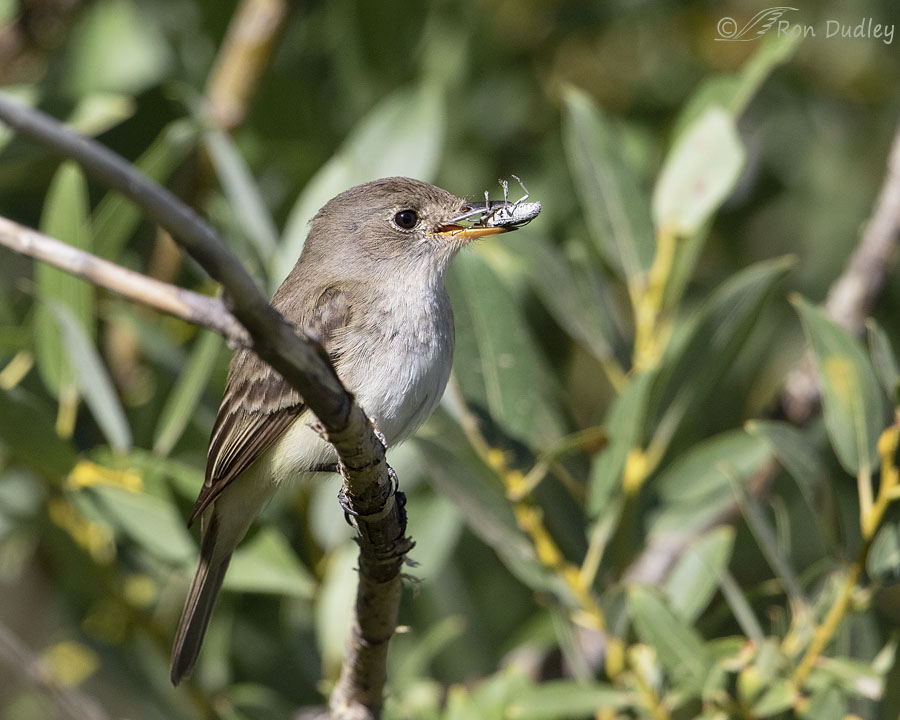
Then he landed on a different perch and played with his meal for a few moments before…
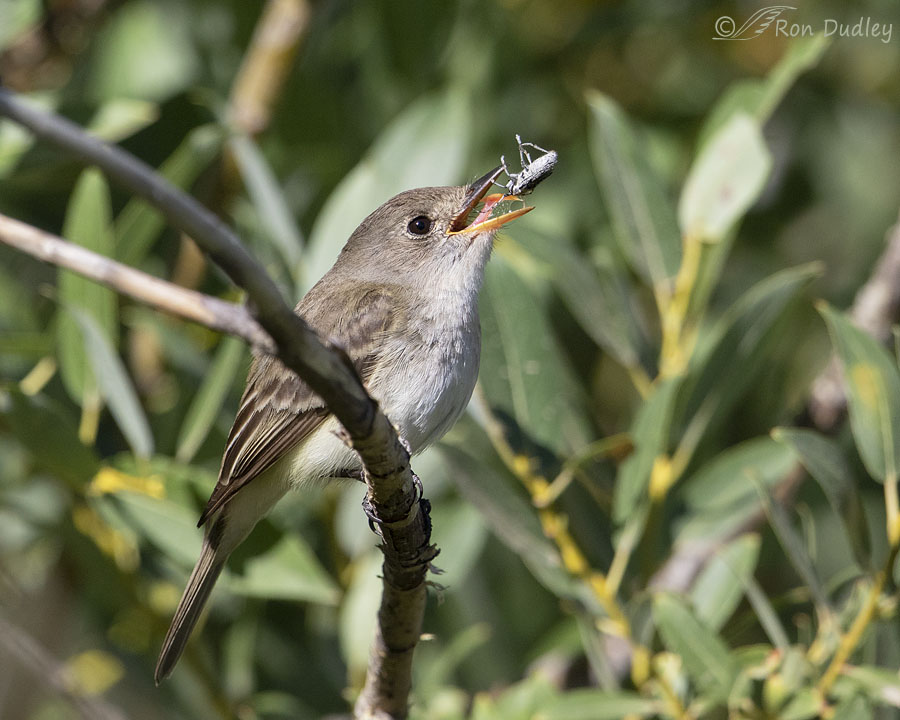
tossing it into the air and gobbling it down. As is often the case in situations like this it all happened so fast I had no idea what I’d captured until I looked at my photos on my big screen at home.
This bird photographer is infinitely jealous of the reaction speed demonstrated by the flycatcher. If my reflexes were that quick I’d rarely if ever be too slow for capturing takeoff shots again. I can only dream.
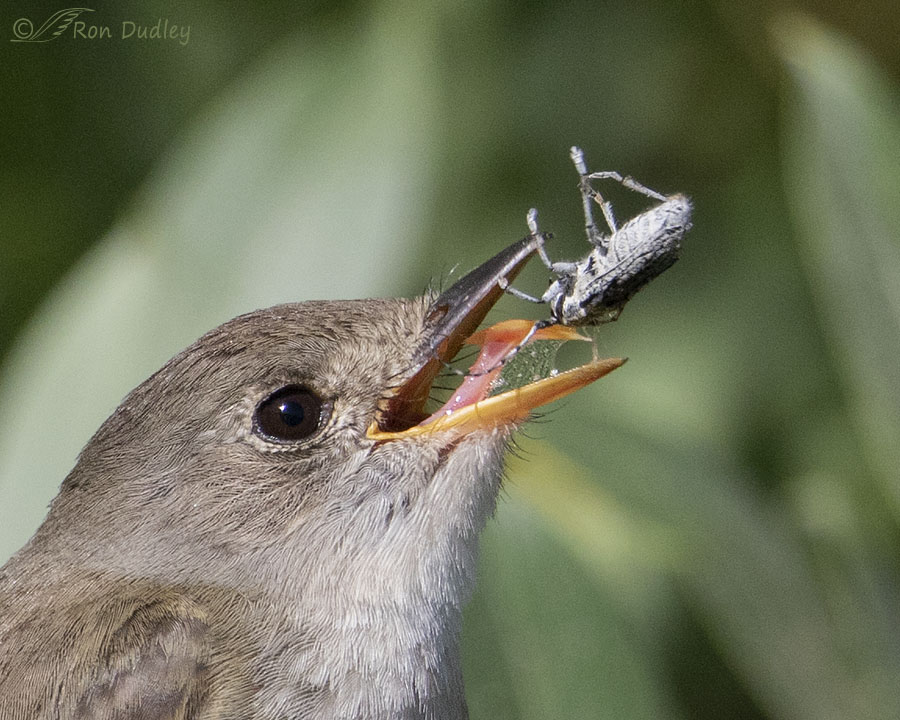
When I zoomed in on the previous photo I was intrigued by the interesting shape of his tongue. Nearly 200 years ago Audubon described the shape of a flycatcher tongue as follows: “The tongue is … triangular, very thin, sagittate and papillate at the base, flat above, pointed, but a little slit, and with the edges slightly lacerated.”
And based on the film of stringy saliva between the tongue and the lower mandible I’ll bet it’s sticky to aid in capturing insect prey on the wing.
Ron
Notes:
- If you’re wondering about some of the terminology in Audubon’s description of a flycatcher’s tongue blog follower Muffy S Gately did the research – “sagittate” and “papillate” means “arrowhead-tipped nipple shape”.
- If anyone can ID the insect I’d be grateful (addendum: a friend of a friend who’s an authority on the subject has definitely ID’d the insect as a long-horned beetle).


Wow, impressive.
Thanks, Jean.
Love this series of remarkable photos. Amazing captures by both you and the flycatcher. I was in awe as I scrolled thru the photos. Still can’t stop smiling! Thanks Ron.
I’m glad you like them that much, Linda. I’m pretty happy with them too, even though I was extremely disappointed by the softness of that third photo.
Hi Ron,
A terrific series – well done.
Gary
Thank you, Gary.
wow……wow….wow
dang, Ron, you have the patience of a saint to sit and wait for these shots
and i know the quick shutter really helps as well
….but just….wow. so amazing this gift of bird photos every day.
a million thanks!
Believe me, Karen. I have very little in common with any saint I’m aware of. But thank you for the very kind words.
The insect looks like a longhorn beetle. Best guess would be a Spotted Tree Borer Beetle (Synaphaeta guexi), based on the jagged black stripes on the wing cases and the black rings on the antennae.
Thanks, Brian – so far it’s unanimous for longhorn or long horned beetle. Two others have said the same thing.
This is a stunning series, Ron! I love hearing “fitz-bew” when I pass a stand of willows in the spring. Thanks again for the close-up. It’s a treat to linger over the details I just don’t get close enough to see in the field!
Thanks, Diane. Thata ‘fitz-bew’ is one of the most common calls I hear in the mountain canyons.
Wow! Fantastic capture. I will be up that way tomorrow morning. More releases.
Today I hiked 2 miles with a dusky grouse in a carrier for release. She has a beautiful new home with other grouse. I put her not too far from where I found the family of dusky grouse the other day. Today I saw 2 males. I did not get photos of the males or the release, the males were very well hidden and the released bird flew out of the carrier like a rocket!
April, I remember being with you when you released a Burrowing Owl near Golden Spike. That owl did the rocket imitation too.
I thought I’d been mighty impressed by your “captures” in the past, but
this series seems at least 1 new rung above…just fascinating– it reminded
me of watching a cat play with its prey– but this involved FLYING, too !
I love tuning into your station every morning–it’s “like a box of chocolates”,
to quote Forrest Gump…….
“it reminded me of watching a cat play with its prey”
Kris, I’ve wondered what made the insect ‘jump’ off to the side like it did. My best guess is that the flycatcher was playing with its food and lost control of it. Couldn’t tell for sure because his head was behind the branch so much of the time.
Oh my goodness, Ron! Every time I think you can’t top yourself, you do it again! (Curse that one wayward branch! *shakes fist*)
The closeup is really cool! Looks like some of that saliva is attached to the bug. Wonder if Dr. T. might be able to help with ID. (Argh, can’t remember his name — you know, the insect guy you’ve sent stuff to in the past. Damn, this getting old stuff.)
Marty, believe me I DID curse that branch!
I’ve even had thoughts of bringing my .22 along and shooting that annoying curved branch off of the kingfisher’s favorite perch. I’d never do it of course but I’ll admit to having the thought.
Oh Ron, I’d settle for 1% of their athleticism, their agility, and their grace of being. Just that small percentage would improve my life exponentially! But I’m merely human. (And don’t forget that I’ve stipulated the OH WOW thing…LOL!)
And when I ponder the idea of catching my food, my subsistence, on the wing, chasing and catching folks who are also flying, my mind just explodes. WOW! REALLY? Yes, really!
Raptors have a nearly-identical tongue design and what a miracle of evolutionary design it is! Although it wouldn’t work well for most of us humans (except for those weird folks who endeavor to shove as many hot dogs into their gullets as possible in a short period of time), it works well to haul food back into their throats–especially food stuffs that aren’t quite dead yet and who have a different plan for their day and try to escape their fate of turning into a bird or a hawk.
Oh and I LOVE the zoomies!
Laura, if I had to catch my own wild food I’d starve. It might have taken me longer when I was younger and more agile but I’d be a goner in no time now.
Poor beetle (or whatever it is) didn’t have a chance against the prowess of that flycatcher! More fantastic behavioral and action photography—thanks!
It sure didn’t. Thanks, Chris.
Just WOW, Ron! I dearly love the photo of the flycatcher recapturing his prey! Amazing that you were able to photograph that moment. I love the bird’s outstretched wings and determined focus. Thank you again for all you do and suffer to share your photographs with us.
Thanks very much, Melanie.
What Melanie said
Awww… the anticipation of seeing what you have when you get home For first time I videoed our baby Bald. It came right at me so fast. Not sure what I had until I got home.
For first time I videoed our baby Bald. It came right at me so fast. Not sure what I had until I got home.
Like you I was happy with the results
Going through my images is a little like a treasure hunt, Diana. Takes some of the drudgery out of culling.
I posted with a link so my comment may have gone to spammity spam spam. Longhorn beetle is my guess. I found an image of a golden-bloomed grey longhorn beetle that looks close.
I looked it up and yes, it does look pretty close. Thanks Arwen, it’s at least a start.
Wow…really great photos. Thanks, Ron!
Thank you, Mary.
VBG! Wonderful capture and information! That tongue IS amazing – WOW! Those little flycatchers CAN move…….never thought of them catching insects other than in the air.
Flycatchers and Night Hawks busy this morning…….
“never thought of them catching insects other than in the air”
You’re right, Judy. Cornell says the Willow Flycatcher is “primarily an aerial forager”. Who knows, maybe this bug can fly (wings tucked and hidden like in beetles?).
Fantastic captures, wonderful close-up – great views and a lesson for all would-be fast or try to be fast avian photographers. Many thanks for the post! Stay safe.
Thank you, Dick.
Truly amazing performance by bird and photographer! The tongue description and the zig-zag saliva pattern were very enlightening!
Thanks, Kenneth. I’m not a fan of some of Audubon’s field methods but you have to give him credit for being a meticulous observer.
What remarkable photography. Not surprised that you knew little about the photos until you put them on the screen. Had you been able to know exactly what was happening while photographing you would have had to have the eyes of an eagle. And it sure pays to have been a biology teacher to assist you in doing the write up. When my wife went back to Cal Poly in her 40’s to get her degree in Horticulture there was a period when she was studying entomology and I would help her in her search for certain insects she needed to collect. I remember some of them, but no help from me in identifying this one.
“Not surprised that you knew little about the photos until you put them on the screen”
Everett, all I knew at the time was that he had a bug on two different perches. That was it.
That’s one of the reason I like firing in bursts at certain times. You just never know what you might capture.
The tongue view is very interesting and had given me many questions to answer and research. I am training with Hawkwatch Intl. as a docent, so I have explained Jack, the Merlin’s, tomial tooth, but what is the flycatcher’s version on the lower mandible called?
Suzanne, as far as I know flycatchers don’t have anything on their lower mandible that resembles a tomial tooth although the tip of their upper mandible is hooked.
Please tell Nikki and Tana at HWI hello for me. And Galileo of course